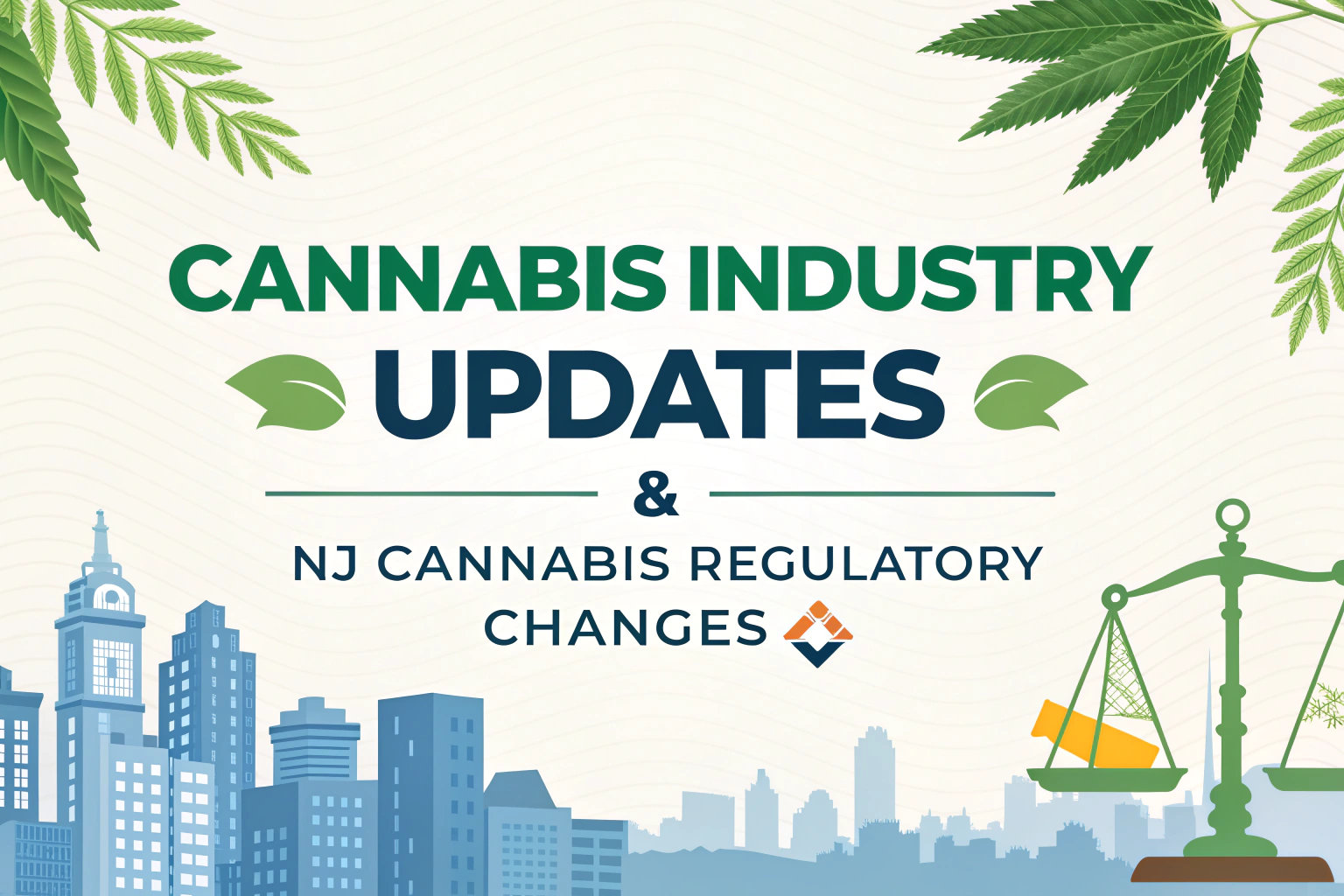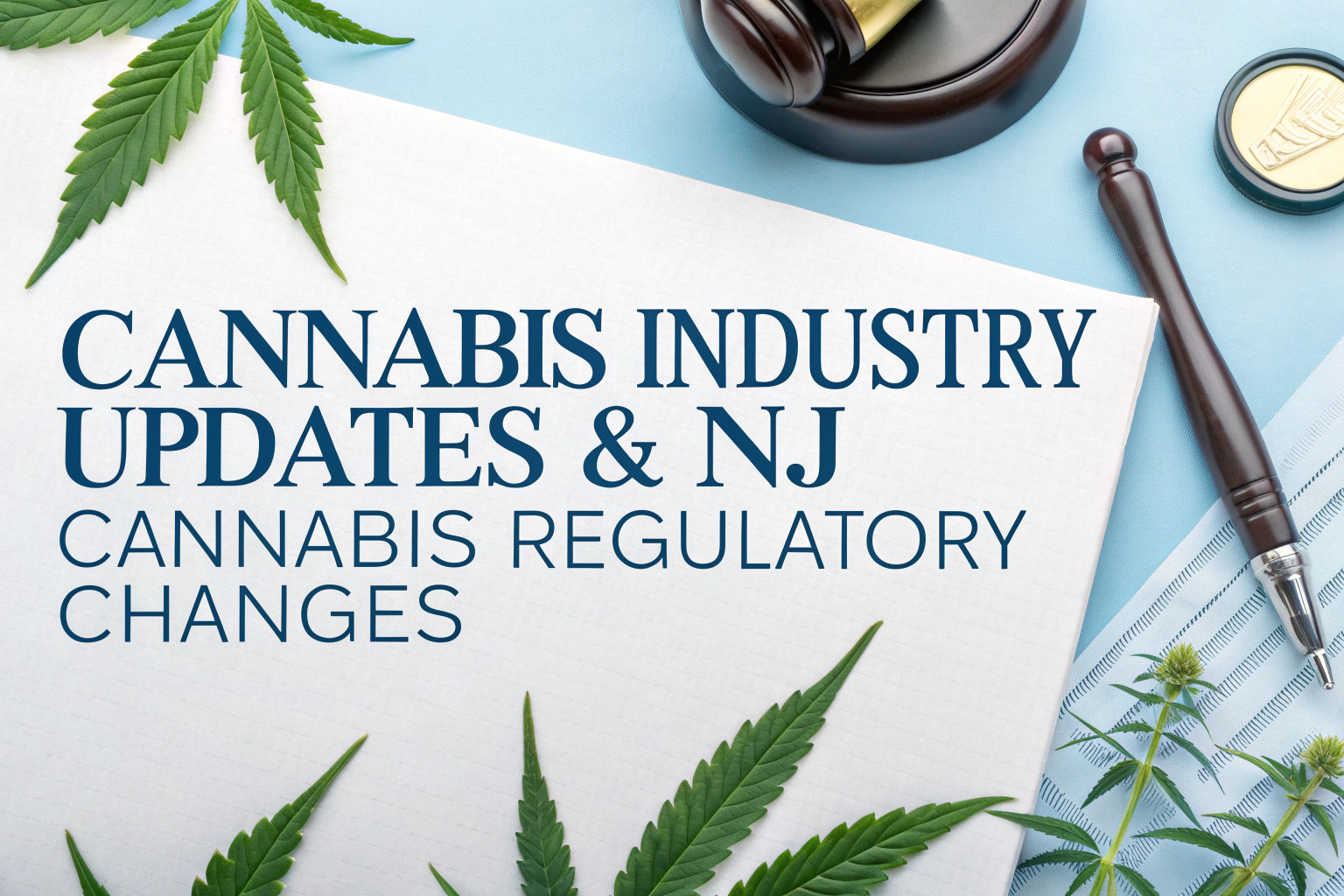
Cannabis Industry Updates & NJ Cannabis Regulatory Changes
The cannabis industry continues its remarkable evolution in 2025, with significant developments reshaping both national markets and state-specific regulatory frameworks. From federal rescheduling proceedings to New Jersey’s pioneering social equity initiatives, the landscape presents both unprecedented opportunities and complex challenges for businesses and consumers alike.
The U.S. cannabis market is projected to reach $45.35 billion in 2025[1], representing an 11.51% increase from the previous year’s $38.5 billion. This growth occurs despite ongoing federal-state legal tensions and evolving regulatory compliance requirements across 24 states that have legalized recreational cannabis and 38 states with medical programs. The industry now supports over 425,000 full-time jobs[2] and has contributed $115.2 billion to the U.S. economy, demonstrating its significant economic impact even under federal prohibition.
Federal cannabis regulatory developments shape industry direction
The most anticipated development remains the cannabis regulatory rescheduling process, where cannabis could move from Schedule I to Schedule III classification. However, the DEA administrative hearings originally scheduled for January 2025 have been postponed until at least April 2025[3] due to legal appeals over alleged improper communications during the rulemaking process. This delay creates continued uncertainty for businesses planning their 2025 operations and financial strategies.
If rescheduling proceeds, the elimination of IRS Section 280E restrictions could transform industry profitability[4]. Currently, cannabis businesses face effective tax rates of 60-70% because they cannot deduct normal business expenses like rent, payroll, and equipment costs. State-legal cannabis companies paid over $1.8 billion in excess taxes in 2022 alone, making rescheduling a potential game-changer for cash flow and operational sustainability.
The SAFER Banking Act presents another critical federal development, having passed the Senate Banking Committee 14-9 in September 2023[5]. The legislation would provide “safe harbor” protections for financial institutions serving state-legal cannabis businesses, potentially ending the cash-only operations that plague most dispensaries. Currently, only ~815 banks and credit unions serve cannabis businesses nationwide, charging $1,000-$2,500+ per account monthly due to compliance complexity.
New Jersey cannabis regulatory framework sets national standards
New Jersey cannabis regulation has emerged as a national model, with the New Jersey Cannabis Regulatory Commission (NJ-CRC) implementing sophisticated frameworks that prioritize equity, safety, and market transparency[6]. Under Acting Executive Director Christopher Riggs’s leadership since April 2024, the nj cannabis program has demonstrated remarkable success in exceeding statutory diversity benchmarks while maintaining robust regulatory oversight.
The state’s social equity performance exceeds expectations across all metrics[7]: 47% of annual license awardees are majority minority-owned, 44% are majority woman-owned or disabled veteran-owned, 16% went to social equity businesses, and 17% to Black-owned entities. This significantly surpasses the 10% of state businesses typically owned by these demographics, demonstrating the program’s effectiveness in addressing historical inequities.
Cannabis consumption areas represent New Jersey’s latest innovation[8], with applications opening in phases throughout 2025. Social Equity designated retail businesses could apply beginning January 2, 2025, followed by microbusinesses and Diversely-Owned dispensaries on April 2, and all other Class 5 retail operators on July 2. The first four consumption area endorsements were approved in July 2025 for High Rollers Dispensary and SunnyTien Dispensary (both in Atlantic City), Gynsyng (Merchantville), and URB’N Dispensary (Newark) – all Diversely-Owned Businesses.
The Social Equity Excise Fee (SEEF) increased to $2.50 per ounce effective January 1, 2025, doubling from the previous $1.24 rate. This fee supports education, economic development, and social services for communities negatively impacted by cannabis criminalization. However, Governor Murphy’s 2026 budget proposal suggests increasing SEEF to $15 per ounce, which would represent a six-fold increase from current levels.
Market performance demonstrates sustained growth momentum
New Jersey cannabis market performance continues impressive growth, with over $1.05 billion in adult-use sales from June 2024 to June 2025, representing a 17.3% year-over-year increase[9]. Monthly sales consistently exceed $80 million, with June 2025 reaching $93 million. The combined recreational and medical market generated $789.8 million in revenue during 2024, contributing $43.3 million in industry tax revenue.
Nationally, the cannabis industry shows similar strength with 2024 legal cannabis sales reaching $30.1 billion, a 4.5% increase year-over-year[10]. States generated their highest single-year cannabis tax revenue total of $4.4 billion in 2024[11], bringing cumulative state tax revenue since 2014 to $24.7 billion. Leading revenue generators include California ($1 billion+), Illinois ($578 million), Michigan ($524 million), and Washington ($516 million).
Product distribution patterns reveal consumer preferences[12]: flower maintains 41% market share, followed by vape cartridges at 29%, edibles at 14%, and other products at 17%. Pre-rolls emerged as the fastest-growing category nationally with 11.89% year-over-year growth, while cannabis beverages grew 11% with $54 million in total sales.

Regulatory compliance requirements intensify across markets
Regulatory compliance demands continue expanding as states mature their oversight capabilities[13]. Cannabis news from California reveals the Department of Cannabis Control implementing Assembly Bill 195 requirements for enhanced track-and-trace reporting, particularly affecting delivery operations. The state shut down $29.9 million in illegal cannabis operations across Southern California in recent enforcement efforts.
New York’s Office of Cannabis Management launched new Adult-Use Processor Type 3 branding licenses while updating school proximity approaches to align with Cannabis Law § 72(6). The Social and Economic Equity (SEE) program targets 50% of all licenses to disproportionately impacted communities, setting ambitious equity goals.
Compliance technology providers face growing demand[14], with Metrc maintaining 50% market dominance across 43 U.S. states and territories where cannabis is legal. BioTrack holds 24% market share, while Leaf Data Systems captures 6%. These seed-to-sale tracking systems require 24-hour reporting for retail sales, automated inventory management, and real-time regulatory agency access.
OSHA launched targeted audits focusing on Class 1 Division 2 extraction facilities, emphasizing fire safety, personal protective equipment, and respiratory protection. Companies face potential “business-ending shutdowns and fines” if non-compliant, requiring substantial investments in employee training programs and spark-proof systems.
Industry consolidation accelerates amid market maturation
Cannabis news highlights significant merger and acquisition activity expected in 2025, with industry experts predicting a wave of consolidation as larger operators acquire distressed assets[15]. 2024 M&A volume reached $1.169 billion, though down 33% from 2023’s $1.749 billion, reflecting strategic shifts from expansion to optimization.
Notable transactions include Vireo Growth Inc. acquiring four single-state operators across Missouri, Nevada, Utah, and Florida, expanding to seven states. Trulieve Cannabis acquired Harvest of Ohio, adding dispensary licenses, while Planet 13 acquired Florida-based VidaCann LLC for approximately $50 million[16].
Multi-State Operators (MSOs) are reshaping their portfolios[17], with Curaleaf Holdings operating across 19 states after exiting California, Colorado, and Oregon. Green Thumb Industries focuses on 13 states, emphasizing Maryland, Minnesota, and New York expansion. This “optimization” strategy reflects market maturation and the need for operational efficiency over territorial expansion.
Technology innovation drives operational efficiency
The cannabis industry increasingly adopts artificial intelligence, blockchain technology, and automated systems to enhance regulatory compliance and operational efficiency[18]. Cannabis businesses implement AI-powered marketing and POS systems, while e-commerce cannabis sales are projected to increase 300% by 2025.
Sustainability initiatives gain momentum, with 69% of consumers preferring sustainable packaging as the industry addresses single-use plastic concerns. ComplianceQuest’s Salesforce-based platform serves 2,000+ organizations with automated workflows, regulatory updates, and non-compliance alerts, demonstrating growing demand for comprehensive compliance solutions.
Consumer demographics and preferences evolve
Cannabis industry demographics show significant shifts, with women comprising more than one-third of cannabis consumers for the first time, surpassing men[19]. Millennials represent 46.2% of cannabis sales, while Gen Z shows the fastest growth at 11.3% market share increase. These demographic changes influence product development and marketing strategies across the industry.
Usage statistics indicate 15% of Americans are active marijuana users[20], up from 14% in 2021-2022. Interestingly, 21% of Dry January participants replace alcohol with cannabis, suggesting evolving substance preferences among health-conscious consumers.
Banking and financial services slowly expand access
Despite federal banking restrictions, gradual progress emerges in cannabis financial services[21]. Dispensaries accepting debit cards earn an average of $4,627 more per day than cash-only retailers, with 59% more transactions processed at debit-accepting locations. This demonstrates significant consumer demand for cashless payment options.
Affinity Federal Credit Union and similar institutions provide comprehensive cannabis banking solutions including checking, savings, mobile banking, and armored cash transport partnerships. However, cannabis businesses typically pay $1,000-$2,500+ per account per month due to compliance requirements and limited competition among financial service providers.
Future outlook presents mixed opportunities and challenges
The cannabis industry outlook for 2025-2030 reveals continued growth potential amid persistent regulatory complexity[22]. Market projections suggest reaching $67.2 billion by 2030 and $87.0 billion by 2035, driven by state-level legalization and federal policy evolution. The global cannabis market expects to reach $102.1 billion by 2030 with an 18% compound annual growth rate.
New Jersey cannabis regulation will likely influence other states’ approaches, particularly regarding social equity implementation and consumption area frameworks. The state’s success in exceeding diversity benchmarks while maintaining market growth provides a replicable model for emerging cannabis markets.
However, challenges persist including federal-state legal conflicts, banking access limitations, Section 280E tax burdens, and interstate commerce restrictions[23]. Small and midsize businesses face particular pressure from compliance costs and market consolidation, while consumers navigate varying quality standards and limited research due to federal restrictions.
Regulatory compliance requirements will likely intensify as states mature their oversight capabilities and prepare for potential federal legalization. Businesses investing in compliance technology, safety protocols, and transparency measures position themselves advantageously for continued regulatory evolution.
The next 12-18 months represent a critical period for the cannabis industry, with federal rescheduling decisions, potential banking reform, and continued state-level expansion creating both unprecedented opportunities and complex challenges. Success will depend on maintaining compliance readiness, operational excellence, and strategic positioning for the industry’s next growth phase.
References
1. CannabisMD TeleMed. “30+ Cannabis Industry Statistics: Growth & Trends in 2025.” Available at: https://cannabismdtelemed.com/blog/30-cannabis-industry-statistics-growth-trends-in-2025
2. Harris Sliwoski. “Cannabis Industry Now Supports More Than 440,000 Jobs.” Available at: https://harris-sliwoski.com/cannalawblog/the-cannabis-industry-now-supports-more-than-440000-full-time-jobs/
3. DopeCFO. “Cannabis Rescheduling in 2025: Expert Insights on Policy Changes.” Available at: https://www.dopecfo.com/blog/cannabis-rescheduling-in-2025-expert-insights-on-federal-policy-changes
4. Marijuana Policy Project. “What is 280E?” Available at: https://www.mpp.org/policy/federal/what-is-280e/
5. Congress.gov. “S.2860 – SAFER Banking Act.” Available at: https://www.congress.gov/bill/118th-congress/senate-bill/2860
6. New Jersey Cannabis Regulatory Commission. “Growth, Equity, and Impact: NJ-CRC 2024 Year in Review.” Available at: https://www.nj.gov/cannabis/highpoints/20250107.shtml
7. New Jersey Cannabis Regulatory Commission. “Growth, Equity, and Impact: NJ-CRC 2024 Year in Review.” Available at: https://www.nj.gov/cannabis/highpoints/20250107.shtml
8. New Jersey Cannabis Regulatory Commission. “NJ-CRC announces 2025 SEEF rate and application dates for cannabis consumption areas.” Available at: https://www.nj.gov/cannabis/news-events/20241213.shtml
9. New Jersey Cannabis Regulatory Commission. “Growth, Equity, and Impact: NJ-CRC 2024 Year in Review.” Available at: https://www.nj.gov/cannabis/highpoints/20250107.shtml
10. Cannabis Business Times. “US Cannabis Industry Revenue Grows to $30B, Jobs Stall at 425,000.” Available at: https://www.cannabisbusinesstimes.com/industry-headlines/news/15745739/us-cannabis-industry-revenue-grows-to-30b-jobs-stall-at-425000
11. NORML. “Analysis: Legal Cannabis Markets Have Generated $25 Billion in State Tax Revenue.” Available at: https://norml.org/news/2025/06/05/analysis-legal-cannabis-markets-have-generated-25-billion-in-state-tax-revenue
12. Flowhub. “2025 Marijuana Industry Statistics.” Available at: https://www.flowhub.com/cannabis-industry-statistics
13. Cannabis Science Tech. “Cannabis Compliance in 2024: A Transformative Year.” Available at: https://www.cannabissciencetech.com/view/cannabis-compliance-in-2024-a-transformative-year
14. Metrc. “Cannabis Compliance Tracking System and Software.” Available at: https://www.metrc.com/
15. AlphaRoot. “Consolidation in Cannabis: What’s Happening With Mergers and Acquisitions? [UPDATED 2025].” Available at: https://alpharoot.com/insights/consolidation-in-cannabis/
16. MJBizDaily. “M&A, interstate expansion areas for 2025 marijuana opportunities.” Available at: https://mjbizdaily.com/mergers-acquisitions-interstate-expansion-areas-for-cannabis-opportunities-in-2025/
17. MJBizDaily. “Where marijuana multistate operators are located by state.” Available at: https://mjbizdaily.com/where-marijuana-multistate-operators-are-located-by-state/
18. Nasdaq. “Cannabis Market Forecast: Top Trends for Cannabis in 2025.” Available at: https://www.nasdaq.com/articles/cannabis-market-forecast-top-trends-cannabis-2025
19. McGowan Wholesale. “2025 Predictions: Key Cannabis Industry Trends and Consumer Behaviors.” Available at: https://www.mcgowanwholesale.com/2025-predictions-key-cannabis-industry-trends-and-consumer-behaviors/
20. Flowhub. “2025 Marijuana Industry Statistics.” Available at: https://www.flowhub.com/cannabis-industry-statistics
21. American Bar Association. “SAFER Banking Act: Marijuana May Soon Become a Bigger Deal.” Available at: https://www.americanbar.org/groups/business_law/resources/business-law-today/2024-february/safer-banking-act/
22. Grand View Research. “U.S. Cannabis Market Size & Share | Industry Report, 2030.” Available at: https://www.grandviewresearch.com/industry-analysis/us-cannabis-market
23. Vanderbilt Law School. “Interstate Commerce in Cannabis” by Robert Mikos. Available at: https://scholarship.law.vanderbilt.edu/faculty-publications/1223/

